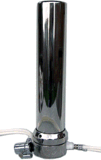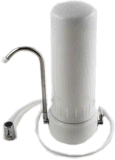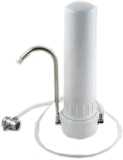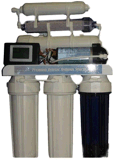| The U.S. General Accounting Office
reports that there are serious deficiencies in water treatment plants in
75% of the states. More than 120 million people ( about 50% of
the population) may get unsafe water according to a study conducted by
the Natural Resources Defense Council.
U.S. Health Officials estimate 900,000 people each year become ill -
and possibly 900 die - from waterborne disease. The General Accounting
Office estimates 66% of Safe Drinking Water Act violations arenít
reported.
The contamination
of water is directly related to the degree of contamination of our
environment. Rainwater flushes airborne pollution from the skies,
and then washes over the land before running into the, rivers, aquifers,
and lakes that supply our drinking-water. All of the chemicals generated
by man will eventually end up in our water supplies. Nearly 70% of
Americans are worried about the quality of their drinking water, yet few
realize that water that looks tastes and smells good can be hazardous to
your health.
Lead is considered the number one health threat
to children, and the effects of lead poisoning can last a lifetime.
Not only does lead poisoning stunt a childís growth,  damage the nervous system, and cause learning disabilities, but it is
also now linked to crime and anti-social behavior in children.
damage the nervous system, and cause learning disabilities, but it is
also now linked to crime and anti-social behavior in children.
Lead is a soft material that is resistant to corrosion. Lead has been
used by many civilizations to transport water, and used as early as the
times of Rome. Lead is used primarily for lead pipe line, lead solder
and brass fixtures. Lead is also added to metal alloys such as brass and
bronze, as such, it is used in water faucets and fixtures. Lead has a
variety of other uses. Lead is a toxic substance and has adverse
effects on human health. Even low levels in drinking water, when
continuously ingested, will cause a deterioration in health.
Exposure to lead produces many different health problems. These effects
are cumulative and usually are irreversible, especially in sensitive
populations such as fetuses, children, and pregnant women .
It has long been known that lead in drinking
water is highly toxic, and recent developments have increased the level
of concern. Contamination of drinking water with significant levels
of lead is much more widespread than previously believed, and levels
that were once considered safe are now know to be health threats.
Exposure to lead is cumulative over time. High concentrations of lead
in the body can cause death or permanent damage to the central nervous
system, the brain, and kidneys. This damage commonly results in behavior
and learning problems (such as hyperactivity),memory and concentration
problems, high blood pressure, hearing problems, headaches, slowed
growth, reproductive problems in men and women, digestive problems,
muscle and joint pain.
Infants, children,
pregnant women, and fetuses are more vulnerable to lead exposure than
others because the lead is more easily absorbed into the sensitive
tissue of actively growing bodies. An equal concentration of
lead is more destructive in a child than in an adult. Pregnant women
should also be especially cautious about lead exposure, because it can
cause premature birth, and reduce the birth weight of babies.
The U.S. Center for Disease Control reports approximately 7,500 cases
of illness linked to drinking water in the United States each year. This
number is much lower than what is generally accepted because drinking
water contaminants are often not considered in the diagnoses of
illnesses. Lead is "a highly toxic metal the agency considers
a major public health threat.", according to the U.S. Environmental
Protection Agency (EPA). The national Centers for Disease
Control considers lead to be the country's number one preventable
pediatric health problem. More than 30 Million Americans are drinking
water with lead levels in excess of the Maximum Contaminant Level set by
the EPA.
According to the recently released lead
toxicological profile for lead from Agency for Toxic Substances and
Disease Registry (ATSDR), the adverse
health effects of lead range from slight increases in blood pressure at
10 ug/dL to severe retardation and even death at very high blood-lead
levels of 100 ug/dL. High lead levels in pregnant women increase
the risk of complications in their pregnancies, and damage to the
fetuses. High lead in men can cause heart attack, high blood pressure,
strokes, and hypertension.
Over 98% of homes in the
U.S. have pipes that contain lead or lead solder. The main
sources are lead pipes, or copper pipes connected by lead solder, and
from brass faucets, which also contain lead ( most chrome plated faucets
are made of brass which is 8% lead). The level of lead in tap water
should not exceed 5 parts per billion.
Here is what the experts
say:
According to the USA TODAY, May 12, 1993, "Drinking water
supplied to 30 million people in 819 cities contains unhealthy levels of
lead", an unprecedented new EPA study says. Children are
especially susceptible to lead poisoning, which can impair mental and
physical development.".
Childrenís lead exposure is linked to crime, according to the
Wisconsin State Journal, February 7, 1996. " Researchers using a
new test that looks for lead in the bones instead of the blood say
exposure to the toxic metal may contribute to crime and anti-social
behavior in children.".
The Environmental Protection Agency publishes a consumer oriented
pamphlet entitled "Lead In Your Drinking Water." Included in
the pamphlet is the following recommendation for consumers who are
considering buying a water filtration device: "It is highly
recommended that before purchasing a filter you verify the claims made
by the vendor. The National Sanitation Foundation (NSF International),
an independent testing agency, evaluates and certifies the performance
of filtering devices to remove lead (and several other harmful
substances) from drinking water." |









